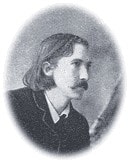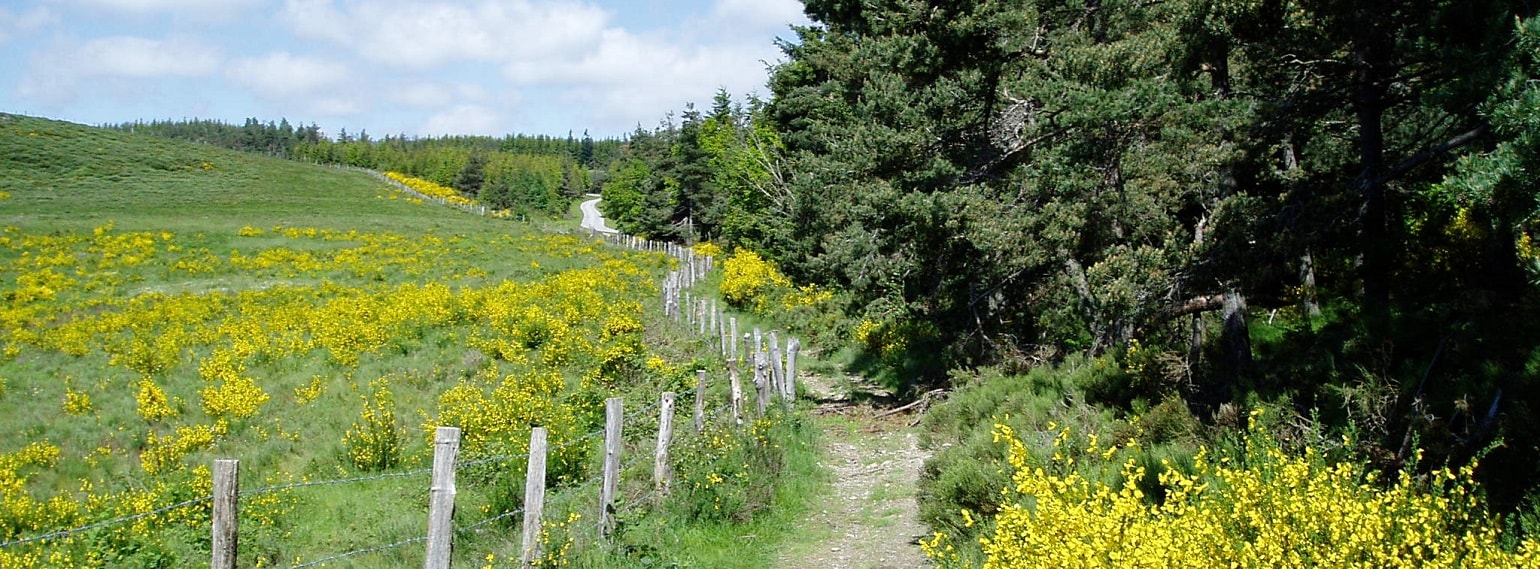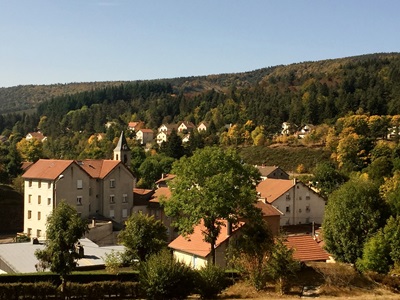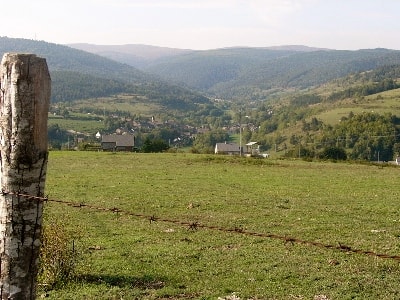

|
Following the GR®70 Stevenson Trail from La Bastide-Puylaurent to Le Bleymard via Chabalier, Chasserades, Mirandol, Estampe, and Les Alpiers in Lozere |


 Before the opening of the railway line in the 19th century, La Bastide-Puylaurent was just a small hamlet known simply as Puylaurent. Today, the place boasts several hotels, guesthouses, shops, a train station, and a nearby campsite. It was from here that I set off early, passing by a facade adorned with a painting depicting Stevenson and his Modestine on their wanderings, and crossed the Allier River via a bridge that led me back into Gevaudan.
Before the opening of the railway line in the 19th century, La Bastide-Puylaurent was just a small hamlet known simply as Puylaurent. Today, the place boasts several hotels, guesthouses, shops, a train station, and a nearby campsite. It was from here that I set off early, passing by a facade adorned with a painting depicting Stevenson and his Modestine on their wanderings, and crossed the Allier River via a bridge that led me back into Gevaudan.
Having become accustomed to the constant changes of valleys, mountains, depressions, plateaus, hills, and ridges, it didn’t surprise me that uphill hiking was on the agenda again this morning. I tackled the following slope, ascending 250 meters to a plateau, in just under an hour. It was a bit too early for a break, but there, waiting for me, was an inviting bench, complete with a table. I sat down, removed my Modestine’s gear, and felt the urge to sing. After a brief warm-up (my voice tends to be a bit hoarse in the early morning), I launched into a song by the German songwriter Hannes Wader:
Here today, there tomorrow,
barely here,
I must go again,
I’ve never complained about it;
I chose it myself,
never counted the years,
never asked about yesterday or tomorrow.
 Likely drawn by the rare plateau matinee, I fell silent immediately as a dog came running after the first verse. This time, however, the dog had a wagging tail. Feeling cheerful myself, I didn’t need to reach for my walking stick in haste. “Arrête,” I heard someone call out as the white-brown-spotted dog reached me, gently resting its long-eared head on my thigh, whimpering softly. With expectant eyes, it looked up at me, its loyalty evident. Knowing proper etiquette, I bestowed a few gentle strokes on its head and shoulder, praising it with, “Good dog, good dog,” even though it likely didn’t understand. Nevertheless, it immediately expressed gratitude by wagging its tail more vigorously.
Likely drawn by the rare plateau matinee, I fell silent immediately as a dog came running after the first verse. This time, however, the dog had a wagging tail. Feeling cheerful myself, I didn’t need to reach for my walking stick in haste. “Arrête,” I heard someone call out as the white-brown-spotted dog reached me, gently resting its long-eared head on my thigh, whimpering softly. With expectant eyes, it looked up at me, its loyalty evident. Knowing proper etiquette, I bestowed a few gentle strokes on its head and shoulder, praising it with, “Good dog, good dog,” even though it likely didn’t understand. Nevertheless, it immediately expressed gratitude by wagging its tail more vigorously.
Its proud owner, who eventually caught up with us, assured me that his dog was entirely harmless and asked if I would kindly finish singing my song. I gladly fulfilled the request for the cheerful retiree. He applauded enthusiastically and became almost as friendly as his dog, inquiring curiously about where I was headed, where I came from, and why I was traveling alone. After dutifully answering his questions, I felt compelled to serenade him with another tune. I chose a song for which I knew the first verse in French from memory and began:
 Chevaliers de
la table ronde,
Chevaliers de
la table ronde,
Goûtons voir si le vin est bon;
Goûtons voir, oui, oui, oui,
Goûtons voir, non, non, non,
Goûtons voir si le vin est bon.
Full of enthusiasm, he sang along and immediately struck up the second verse:
S' il est bon, s' il est agréable,
J' en boirai jusqu'à mon plaisir.
J' en boirai, oui, oui, oui,

Having tidied herself up, she allowed me to take a photo of her with the scarecrow in the background. Even this ensemble, especially with me in the trio, would have scared off the boldest crows. Since I had nothing better at hand, I thanked her with my business card, which she happily tucked away in her vest pocket.
In Chabalier, I crossed the Allier River one last time, now just a tiny stream near its source, to reach the Chassezac Valley at Chasserades.
“That evening, the company in the inn’s kitchen consisted only of men who were conducting survey work for the planned railway line. They were intelligent and talkative, and over mulled wine, we made decisions about France’s future until the clock chased us to rest.” (Stevenson)
Now I stand beneath a 30-meter-high railway bridge that spans the Chassezac Valley. At the base of one of the viaduct’s pillars, which cut through the valley like gigantic saw teeth, a stone memorial plaque commemorates four young workers who tragically lost their lives here on October 4, 1899. Underneath this monstrous structure lies the small idyllic village of Mirandol, cowering in fear. Stevenson would have had harsh words for it.
The path then led alongside the railway track, where my good mood cooled somewhat. Firstly, I thought about the steep ascent that would take me to an elevation of 1400 meters at the Sommet du Goulet. Secondly, the sky darkened, heavy dark clouds announcing a damp hike. And thirdly, I was being pursued by a “four-legged” creature that was getting closer and closer. Recognizing my futility, but also to conserve my energy, I didn’t even attempt to keep my distance by speeding up my pace. Soon, the young wiry Frenchman caught up with me, walking alongside me for a while, his breath light. He was traveling with a tent and planned to spend the evening at a campsite near Le Bleymard. After kindly indicating that our walking pace was too different, we parted ways, but with an arrangement to meet in two days in Le Pont-de-Montvert, in one of the restaurants.
Once he was out of sight, I continued to hear the bright clatter of his walking sticks, which bothered me less now, as I had become a three-legged traveler myself. I attributed his brisk pace not to the use of his sticks but to his good fitness. I consoled myself with the not insignificant age difference and pondered a fitting word for the ascent. Then the first rain began.

“As I continued along the path, I was puzzled by something that felt like cool raindrops falling on my hand. Several times, I looked up at the cloudless sky in wonder until I finally realized it was just sweat dripping from my forehead.” (Stevenson)
After finally climbing the mountain ridge, heavy drops— a mixture of sweat and rain—fell onto my glasses and both hands, which I used to support myself on my walking stick for a rest. The path led me onward, past the source of the Lot River, which would soon become a mighty river in southwestern France, ultimately flowing into the Garonne after 485 kilometers, just before Bordeaux. A strong, pounding rain finally called for my stormproof high-tech umbrella. Then, whistling “Singing in the Rain,” I hopped downhill again. With my walking stick under my arm and the umbrella wedged between my chin and shoulder, I even attempted some contortions, as I urgently needed to relieve myself just before the village of Les Alpiers. Hopefully, no one observed me.
At the entrance to the village, a weathered wooden sign with the words “Tipi d’étape” beckoned me to spend the night. And sure enough, a white Native American-style teepee came into view, set on a green meadow behind an old farmhouse. However, a comfortable bed awaited me at the Hotel La Remise in Le Bleymard, where I arrived late in the afternoon with soaked hiking boots. Here, the Lot River had already grown into a small stream. “With backpack and guitar: On the Chemin de R. L. Stevenson through the Cevennes” by Lino Battiston. BoD – Books on Demand.
Old romantic Hotel, L'Etoile Guest-House is a mountain retreat in the South of France. With a beautiful park along the Allier River, L'Etoile Guesthouse is located in La Bastide-Puylaurent between Lozere, Ardeche and Cevennes. Hiking trails: GR®70 Stevenson trail, GR®700 Regordane way (St Gilles trail), GR®7, GR®72, GR®470 Allier river trail. Hiking loops: Cevenol, Ardechoise, Margeride. The right place to relax.
Copyright©gr-infos.com